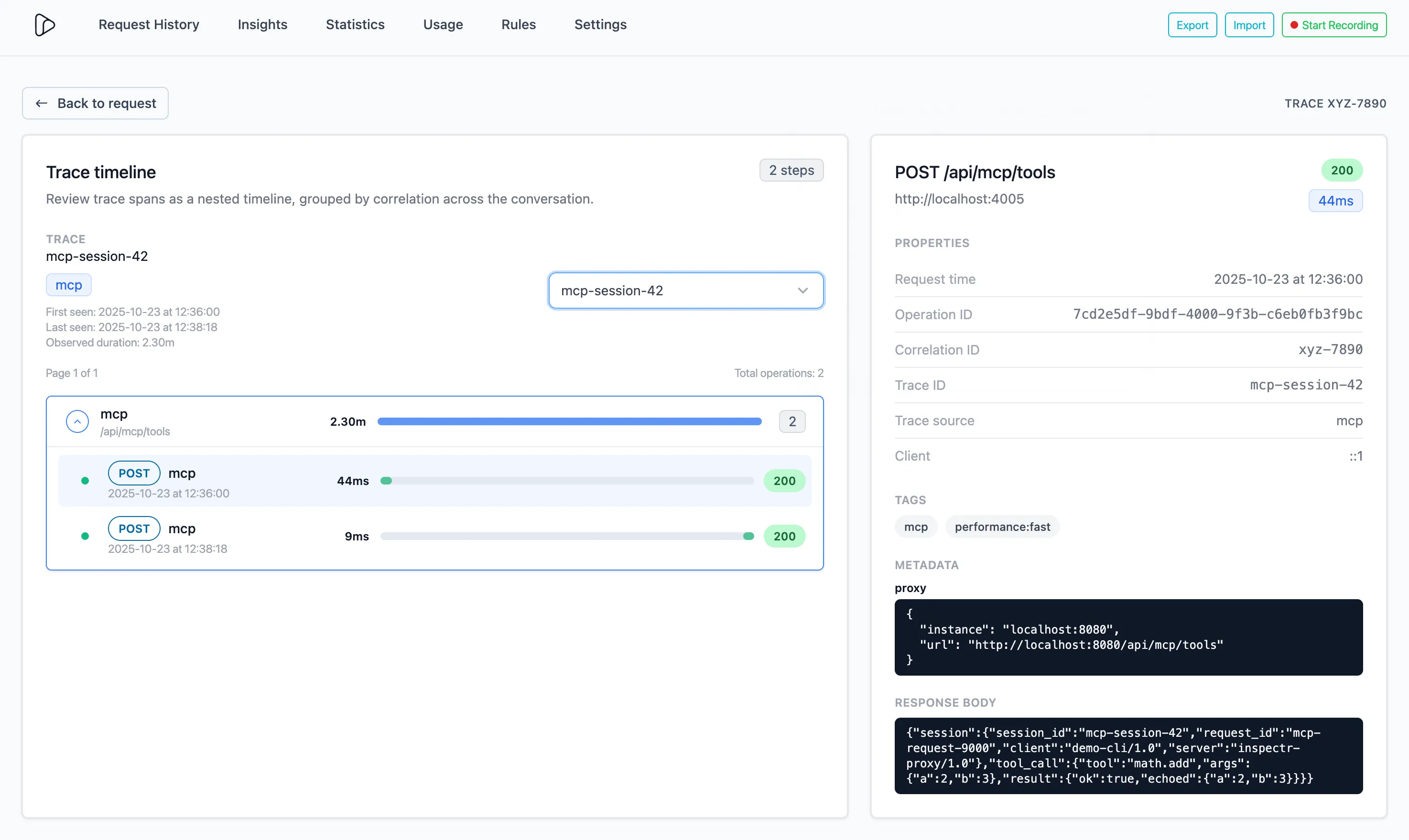Tracing Insights
Inspectr Tracing & Insights — because understanding flow is the first step to mastering observability.
The Tracing & Insights view reveals how requests are connected across sessions, tools, or backends. Each trace groups related requests by their correlation ID and trace ID, letting you see the full conversation timeline in one place.
Inspectr automatically correlates events as they flow through your local proxy, remote ingress, and backends — showing when, where, and how each call occurred.
Tracing feature
Section titled “Tracing feature”Trace Timeline
Section titled “Trace Timeline”Inspectr displays every related request in a nested timeline:
- Visualize the order and duration of each request
- See parent-child spans for chained or recursive calls
- Review total trace duration and time between events
This makes it easy to understand how an incoming webhook triggered a downstream API, or how multiple tools interacted in a workflow.
Correlation Context
Section titled “Correlation Context”Each trace includes the following identifiers:
- Operation ID — the captured OpenAPI operation
- Correlation ID — the shared ID linking related requests
- Trace ID — the unique identifier for each timeline
- Trace Source — where the event originated (e.g. proxy, ingress, MCP client)
Use these fields to pinpoint where a problem starts or to track flow consistency across environments.
Metadata & Payloads
Section titled “Metadata & Payloads”Inspectr keeps context close to the data:
- Metadata sections show proxy origin, client instance, and URL
- Response Body provides a direct view of the payload exchanged
- All contextual information is available side-by-side — no need to jump between logs
Duration & Latency
Section titled “Duration & Latency”Each request node includes precise timing information:
- Request start time
- Duration in milliseconds
- Aggregated total span time
Combined, they help you spot bottlenecks, repeated retries, or slow upstream dependencies.
Tags & Filters
Section titled “Tags & Filters”Attach and filter traces using tags such as:
mcpperformance:fastproxy
Tags make it simple to isolate behavior related to a specific tool, environment, or rule set.
Typical Use Cases
Section titled “Typical Use Cases”- Debugging Webhook Chains — Understand what happens after your app receives a webhook.
- Inspecting Local-to-Remote Flows — Follow traffic from your local Inspectr proxy to a remote ingress.
- Performance Profiling — Identify which step in a multi-call sequence adds latency.
- Validation Testing — Confirm that automation rules triggered expected downstream calls.
Example
Section titled “Example”
In the example above:
- The trace
mcp-session-42shows twoPOST /api/mcp/toolsrequests - Both complete successfully (
200 OK) with durations of44 msand9 ms - Metadata reveals the proxy instance (
localhost:8080) and full call path - Response body displays the echoed payload for quick debugging
Summary
Section titled “Summary”APIs rarely operate in isolation. A single trigger often cascades into multiple requests — through integrations, middleware, or AI agent calls.
Inspectr’s tracing insights give you end-to-end visibility into those conversations. You can follow the full path, measure each operation, and understand easier what happened and why.
